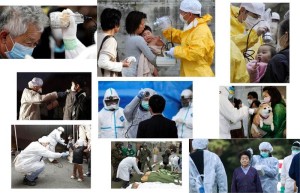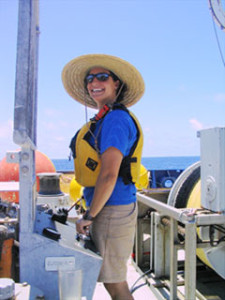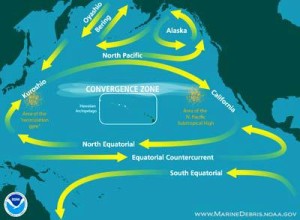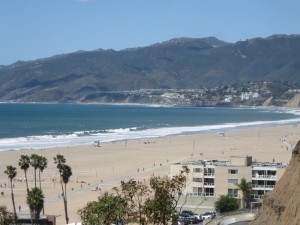Media Meltdown Deniers
TEPCO must surely have been pleased at the snarky and dismissive media that reported on Crain’s radiation findings. Southern California legacy media and some online media commentators decided to decliare Crain’s anonymous video and the reaction to it as just pure fear-mongering. In the process, the coverage showed just has facile and science-challenged the press has become in light of Fukushima’s inexorable onslaught in the Pacific.

The newspaper compounded its errors by saying that “even at its worst” eating cesium-134 (Cs-134) and cesium-137 (Cs-137) contaminated blue fin tuna was like “eating bananas.” This is false.
Bananas contain slightly radioactive potassium-40 (K-40). Humans need K-40 and no matter how many bananas one eats, the body keeps the K-40 at a regular threshold. It doesn’t concentrate in particular organs because of the body’s homeostatic mechanism for regulating K-40. Potassium-40 doesn’t present a threat to the human body for another reason: it has a half-life of 1.248×109 years or about 1.25 billion years.
A half-life is the time necessary for a radioactive substance to drop to half its mass. The shorter the half-life means the more ferocious the ionization is which can damage the DNA of cells and cause oft-times fatal cancer.
Cs-137 and strontium-90 have much shorter half-lives than K-40, 30.17 years and 28.79 years respectively. The half-life of Cs-134 is only 2.07 years so for it to show up anywhere, such as in blue fin tuna caught off a San Diego pier in August 2011, just five months after the meltdowns began, can only be attributed to Fukushima and not fallout from nuclear bomb tests decades ago.
Unlike K-40 in bananas, Cs-137 does concentrate in organs sometimes as much as one hundred times the amount of K-40. “[I]nternal exposure to Cs-137, through ingestion or inhalation, allows the radioactive material to be distributed in the soft tissues, especially muscle tissue, exposing these tissues to the beta particles and gamma radiation and increasing cancer risk,” according to a Centers for Disease Control and Prevention toxicology brief.
 Cesium-137 harms children more than adults even in tiny amounts. Children near Chernobyl in the Ukraine suffered cardiovascular disease showing signs of heart pain, faint heart sounds, systolic murmur on auscultation and heart failure as a result of the 1986 meltdown. Heart disease and cancer are the leading cause of death amongst children in neighboring Belarus.
Cesium-137 harms children more than adults even in tiny amounts. Children near Chernobyl in the Ukraine suffered cardiovascular disease showing signs of heart pain, faint heart sounds, systolic murmur on auscultation and heart failure as a result of the 1986 meltdown. Heart disease and cancer are the leading cause of death amongst children in neighboring Belarus.
Female hormones are also seriously imbalanced by Cs-137 which is a primary cause of infertility. Cs-137 exposure will lead to a prolonged gestation, increased newborn delivery complications and developmental disorders. There is no safe level of Cs-137 in food or drink.
Yet the Los Angeles Times would have its declining readership believe that this fearsome Fukushima radioisotope is as benign as bananas. The fruity fission fib has been a common ruse used to negate high radiation readings by nuclear power allies since nuclear power began.
A snarky style dominated the Los Angeles Times piece that attempted to demean even when at odds with the facts.
“Every single environmental issue was being blamed on Fukushima,” Kim Martini told the paper January 12. “And I thought there’s no way that can be true.”
Martini’s was right. It wasn’t true because what she said wasn’t true. The LA Times reporter should have known that her blanket statement was patently false on the face of it. Instead the paper elaborate on her University of Washington oceanographer background as if that field translates into Fukushima radiation dispersion expertise.
The paper also noted, by way of establishing Martini’s credentials, her contributions to Deep Sea News (DSN). Martini’s November 28 DSN story True facts about Ocean Radiation and the Fukushima Disaster set the tone for the current tide of vocal meltdown deniers. Instead of attempting a sound science appraisal of the triple meltdowns’ threat to the Pacific and North America, the reader is treated to a jokey tautological title and ‘exposé’ filled with more holes than a Fukushima reactor.
 Martini, who lives in an Alaskan yurt and says “her goal in life is throw expensive s**t into the ocean,” got her wish in the piece – so-called facts drown in Martini’s sarcasm. She claimed that the “radioactive rods in the Fukushima power plant are usually cooled by seawater” which is, of course, wrong. Fresh water was used to cool the rods before the nuclear reactors were destroyed by the earthquake and tsunami.
Martini, who lives in an Alaskan yurt and says “her goal in life is throw expensive s**t into the ocean,” got her wish in the piece – so-called facts drown in Martini’s sarcasm. She claimed that the “radioactive rods in the Fukushima power plant are usually cooled by seawater” which is, of course, wrong. Fresh water was used to cool the rods before the nuclear reactors were destroyed by the earthquake and tsunami.
There are so many mistakes in her piece that there are strikeouts and corrections throughout. Some statements imply that Martini and her editors don’t understand the very basics of radiation exposure. “Like I said before, the West Coast will probably not see more than 20 Bq/m3 of radiation,” Martini wrote. “Radiation will increase in the Pacific, but it’s at most 10 times higher than previous levels, not thousands.”
The implications of anything over three times background radiation are huge, let alone 10. Ten times is over three times the CHP’s hazmat trigger. Martini is clearly unaware of the significance of what’s she’s saying.
Martini’s mixes snide fact mangling with incredulous statements like “most fish are kinda lazy” to imply local supplies are safe since most fish don’t migrate to Japan and back to North American waters like blue fin tuna do.
“It’s not even dangerous to swim off the coast of Fukushima,” Martini wrote apparently unaware that over 400 metric tons of highly radioactive water have been gushing into the waters off of Fukushima for over two years. “Hell, the radiation was so small even immediately after the accident scientists did not wear any special equipment to handle the seawater samples (but they did wear detectors just in case). If you want danger, you’re better off licking the dial on an old-school glow in the dark watch.”
That is perhaps the singularly dumbest thing said about Fukushima in the last three years. But how would any normal L.A. Times reader know that?
No meltdown denier screed is complete without the bananas comparison. “You’ll get the same amount of radiation by eating 9 bananas,” Martini summed up in her DSN opus. “Monkeys might be doomed, but you are not.”
The Los Angeles Times article that pushed Martini as its sage expert also looked to Heal the Bay which, according to the paper, had “fielded such a swell of alarmist calls, emails and Facebook inquires that its staff posted an online Q&A.” Note that the callers weren’t alarmed, they were alarmist. That means, according to the ‘paper of record’ in Southern California, that to even be concerned that Fukushima radiation was affecting marine life, the fish we eat or the Pacific was to be not only a fool, but a dangerous one at that.
Also note that like Martini, Heal the Bay betrays its ignorance of the most basic fundamentals of how Fukushima radiation has and will continue to impact the east Pacific along the West Coast.
“It takes years for seawater plumes from Japan to reach U.S. shores,” Heal the Bay says in its “Mythbusting: The Latest from Fukushima.”
 The notion that it would take the plume years to reach us would appear to be a myth in the making itself. That’s not how the Kuroshio Current works according to the United States Navy’s Office of Naval Research.
The notion that it would take the plume years to reach us would appear to be a myth in the making itself. That’s not how the Kuroshio Current works according to the United States Navy’s Office of Naval Research.
“Two of the largest currents are the Antarctic Circumpolar Current and the Kuroshio Current,” the research branch writes in Ocean in Motion: Currents – Characteristics. “The Kuroshio Current, which is located just off Japan’s coast, travels up to 75 miles a day at a speed of up to 3 miles per hour.”
The Navy map of the Kuroshio Current shows it splitting along the West Coast with the southern-bound California Current making its way down the coast to Southern California before turning back west along Baja California. Fukushima is 5,363 miles up current from Los Angeles.
Even adding on extra miles since the water doesn’t flow straight to Southern California, a 6,000-mile long journey from the radioactive shores of Fukushima to the beaches of Malibu takes less than three months, not years.
Another myth perpetuated by Heal the Bay was that something was actually being done specifically to monitor for Fukushima fallout in the air, rain, snow and Pacific.
“Three major federal agencies are currently monitoring radiation from the Fukushima disaster,” Heal the Bays claims, “The National Oceanic and Atmospheric Administration (NOAA) is monitoring marine debris and atmospheric dispersion of radioactive particles; the U.S. Environmental Protection Agency (USEPA) is monitoring air and water for radiation that is harmful to human health; and the Food and Drug Administration (FDA) is monitoring Japanese imports to insure food safety. These agencies work closely together to monitor radiation leveling in the United States as well as our imported goods.”
Heal the Bay is wrong on all counts: NOAA isn’t testing the water for radionuclides and the EPA is generally testing with its RadNet data with nothing specific to Fukushima, let alone any warnings when the beta readings zoom north of 100 CPM. The FDA’s monitoring of food in general, let alone Japanese imports, is woefully undermanned and underfunded. Actual responsibility for monitoring, investigating, sampling and analyzing radiation from Japan is non-existent on both the state and federal levels.
Why does it matter that Heal the Bay is wrong on how long Fukushima infused water takes to get here? Or that it is unaware of how there’s no ongoing state or federal government testing? Because the group is giving out false information under the guise of being expert in the subject. Still, Heal the Bay trumpets its own brand of sloppy science.
“There is a great deal of inaccurate information floating around the Internet about Fukushima radiation and its impacts to human and marine life,” Heal the Bay concludes in its ‘mythbusting’ page. “We recommend double-checking your news sources for credibility, and when in doubt, check out how Heal the Bay is keeping up to date on the most recent news and scientific studies on the Fukushima disaster.”

Heal the Bay wouldn’t know how to deal with its “healthy oceans” under constant siege by Fukushima if it drowned in one of them. No matter to the Los Angeles Times. Heal the Bay and oceanographer Kim Martini have enough ‘credibility’ to blow this dangerous nonsense past the paper. Not just past the writer but his editors too. Any digging would have revealed to the Times what you’ve just read here.












@zach: Apparently you’re a student from St Michael’s Grammar School, an Australian co-educational independent day school located in St Kilda, Victoria that costs tens of thousands of dollars a year to attend. I’m afraid that while that tony education has taught you how to construct poorly-punctuated sentences, it also did not impart the critical thinking skill set that would have enabled you to see that the “perfect crime” that this article exposes had nothing to do with your prattle here. Give it another read.
A perfect crime? why would japan do this to try and harm a few americans when it killed thousands of their own, cost them hundreds of billions of dollars and even made large parts of their own country uninhabitable due to radiation?
I think you have to be pretty big headed to believe that japan decided to do that to attempt to harm a couple of americans in such a far fetched way.
Start having some sympathy for the Japanese who had their lives ripped apart by the disaster.
@All: The U.S. Senate Committee on Environment and Public Works sent EnviroReporter.com the following regarding progress, or shockingly no progress, done to make more safe America’s nuclear power plants and infrastructure. Having just finished Fukushima – The Perfect Crime? will probably have our readers not very surprised at what the outstanding, yet sadly outgoing, junior Senator from California has to say:
Opening Statement of Ranking Member Barbara Boxer
EPW Hearing on “Oversight of the Nuclear Regulatory Commission”
October 7, 2015
(Remarks as prepared for delivery)
Today, the Environment and Public Works Committee is holding an oversight hearing on the Nuclear Regulatory Commission (NRC). I remain concerned about the slow pace at which the NRC is implementing measures intended to protect American nuclear plants in the wake of the earthquake, tsunami, and nuclear meltdowns that occurred in Japan in March 2011.
It has been more than four years since the Fukushima disaster, and Japan continues to face challenges in its cleanup efforts.
Only one of Japan’s 43 nuclear reactors has been turned back on since the Fukushima disaster. A recent analysis by Reuters found that of the other 42 operable nuclear reactors in Japan, only seven are likely to be turned on in the next few years. Reuters also found that “nine reactors are unlikely to ever restart and that the fate of the remaining 26 looks uncertain.”
For the last four years, I have been saying that in order to earn the confidence of the public, we must learn from the Fukushima disaster and do everything we can to avoid similar disasters here in the U.S.
Following the last NRC oversight hearing in April, I met with Chairman Burns to discuss the commission’s progress on implementation of the Fukushima Near-Term Task Force recommendations. I appreciate the letter he sent me after our meeting outlining the status of the commission’s work and anticipated timelines for completing each of the recommendations.
While I recognize that progress has been made on some of the recommendations of the Post-Fukushima Task Force, I am frustrated and disappointed with the overall slow pace. Not one of the 12 task force recommendations has been fully implemented. And many of the recommendations still have no timeline for action.
I am also concerned with some of the decisions the NRC is making on whether to implement important safety enhancements.
In particular, I am troubled that the Commission overruled staff safety recommendations and voted not to move forward with multiple safety improvements. For example, by a 3 to 1 vote, the Commission decided to remove a requirement that nuclear plants have procedures in place for dealing with severe accidents, like the earthquake and tsunami in Japan. These procedures ensure plans are in place when multiple failures of safety equipment occur or other unanticipated events take place.
This requirement was identified in the aftermath of Fukushima, but after years of work on this and other proposals, the Commission simply chose not to move forward. That is unacceptable.
The Commission does not appear to be doing all it can to live up to the NRC’s mission “to ensure the safe use of radioactive materials for beneficial civilian purposes while protecting people and the environment.”
We need to look no further than the two nuclear power plants in my home state. At California’s Diablo Canyon Power Plant, NRC has repeatedly declared the plant safe even after learning of a strong earthquake fault near the plant.
At the San Onofre Nuclear Generating Station in San Diego County, which has been closed permanently, the NRC recently issued exemptions to emergency planning requirements. The plant’s operator will no longer be required to maintain detailed plans for the evacuation, sheltering, and medical treatment of people residing in the 10-mile zone around the plant.
I am aware that the NRC is planning a rulemaking on decommissioning issues, but rubber stamping exemptions the way the Commission has is the wrong approach. I believe it is wrong to relax emergency planning requirements with thousands of tons of extremely radioactive spent fuel remaining at the site. The millions of people living in close proximity to the plant deserve better.
The NRC owes it to the citizens of California and the nation to make safety the highest priority and I urge all the Commissioners to refocus your efforts to do just that.
I look forward to discussing these issues with you today.
It should be mandatory that dispensaries test ‘medicinal’ marijuana for the presence of radiation now-along with pesticides, fungicides, etc. Wise up folks and quit smoking it.
@Eric: While it may be understandable to advocate such an extreme act, that would be terrorism which is unacceptable. Plus, there is no way to diminish the tons of goo at Fukushima by exploding the place sky high – radiation can’t be vaporized away, blown apart or scattered enough to be safe. It would make the massive mess even more unmanageable and deadly to flora and fauna on the land and in the sea.
Nuke the reactors. It would do less harm to the environment and oceans
Very good investigative factual journalism.
With regard to mainstream media’s coverage, it appears OPERATION MOCKINGBIRD is exerting it’s full force on this grave issue. For those who are not familiar, OPERATION MOCKINGBIRD was covertly implemented by the CIA soon after the agency was formed after WWII, for the purpose of infiltrating mainstream media and using it as a propaganda tool to promote their many covert agendas. Even though it was ordered by Congress to cease it during the late 1970s, it obviously was not done, and no oversight exists. Sensitive subjects which hit close to home, such as real investigations into murdered presidents, govt involvement in drug traffic, 911 and other false flag operations that factually implicate the true holders of power, will trigger the CIA’s mocking propaganda machine into high gear. And like paid stooges, the mainstream media falls in line with a synchronized goose step. And innocent victims be damned.
Anti-nuclear legend Harvey Wasserman has Michael Collins on as his guest to discuss Fukushima – The Perfect Crime? in this fast-paced show with a host who really knows his radiation. Collins describes radiation discovered along the Pacific coast in Pacifica and Santa Cruz, California, Fukushima-tainted dirt lab tested from the heart of marijuana growing country in Humboldt County, extremely radioactive rain in Death Valley, high radiation found through US EPA RadNet monitors coast to coast, meltdown deniers successfully pulling the wool over the Los Angeles Times, news aggregators and “alternative” news outlets, and the now-infamous Ventura County Reporter cover art for one of Collins’s 2012 Fukushima stories that shows how clueless the media, and Americans in general, are about the ongoing triple meltdowns that began in Fukushima Japan March 11, 2011. Not to be missed rarity.
This IS the perfect crime, because our stooge governments are allowing TEPCO to get away with it.
Specifically, I like how the Japanese Government has taken to explaining the skyrocketing thyroid cancer rates in Fukushima Prefecture — “it’s because we’re testing more thoroughly, not because there are more cancers.”
Yeah, right. If the Japanese Gov’t wasn’t lying its ass off, it would repeat the Fukushima study somewhere out of the immediate fallout zone, and then compare. Please don’t bet on that happening.
You can read some of the sordid details here: http://www.theguardian.com/world/2014/mar/09/fukushima-children-debate-thyroid-cancer-japan-disaster-nuclear-radiation
It’s about time for a bunch of nuke plant employees to show up and mansplain to us that “hardly any radiation was released, nukes are safe, even YOU eat bananas, and …” because we’re all just supposed to believe all the nuke industry’s bullshit.
There is an amazingly concerted effort going on to trivialize Fukushima. As recently as this week, the Japanese government was explaining away the skyrocketing childhood thyroid cancer rates in Fukushima Prefecture as “we’re doing a better job detecting, that’s all.”
“Ignore this situation at your peril.”
That’s a phrase I’ve heard far too often in my life, as to a variety of economic and public health disasters. With respect to radiation from Fukushima reaching the United States, the warning is appropriate.
In 1986, few Americans had ever heard of Ukraine, when the Chernobyl nuclear power plant explosion and meltdown occurred. Whether out of Soviet egotism and pride, or out of fear of intense public anger and its consequences, the highest levels of the Soviet government made decisions to work in near silence (in terms of what the Soviet public knew) to attempt to staunch the continued atmospheric impacts of the explosion and meltdown. Moscow and Leningrad were far from the accident site, the bureaucrats and decision makers’ children were thought to be relatively safe, and catastrophic decisions were made. The residents of Pripyat, the town nearest the reactor, were not evacuated until 2 days after the explosion. Ukrainians living within 20 miles of the reactor were not evacuated until a month later, while Belarussians living in that 20 mile zone were not evacuated at all. The rest of the Soviet population was not aggressively educated on how best to protect themselves from becoming chronically ill from the variety of sources contaminated by the fall out from the burning reactor.
Literally hundreds of thousands of “Soviet citizens” of no consequence, Belarussians living to the north, Russians living in Bryansk Oblast of Russia to the northeast, and Ukrainians living to the east, west and south of Chernobyl were exposed first to airborne radiation from the explosion and fire, then to radiation in their drinking water drawn from the region’s surface waters, and then to radiation in the meat they ate and milk they drank because animal forage had been radioactively contaminated. Belarussians and Ukrainians were also extensively exposed from radioactive contamination of locally grown grain which went into their every day foods. The Soviet government found it inconvenient to try to prevent the public from unknowingly eating radioactively contaminated food (a situation which continues in Belarus today with particular intensity).
Over the succeeding years, the people living in those regions saw a dramatic increase in cancer and related health problems to such an extent that the people now call it “Chornobyl disease”. Birth defects substantially increased. Children died with more frequency than in other eastern European countries. Individual medical doctors in southwest Russia, Belarus and Ukraine began to undertake independent investigations of the effects of radiation on the health of the people. Those physicians wrote about their findings in medical journals published in the Russian and Ukrainian languages. In autopsies of the region’s dead children their organs were examined and Caesium-137 was found in its highest accumulation in the endocrine glands, in particular the thyroid, the adrenals and the pancreas. High levels were also found in the heart, the thymus and the spleen. The average person-on-the-street in the region now takes for granted the fact that their countrymen are still chronically sick and dying from the radiation.
The Belarussian, Ukrainian and southwest Russians have historically been chronically fatalistic, knowing that “Life stinks then you die” (a translation of a sentiment expressed in both languages.) As a consequence, the public at large in those countries knows and understands the “consequences of the Chernobyl explosion and fire” from practical experience and they soldier on.
Yet there were at least 7 non-Soviet organizations with “western” orientation which conducted public health studies in the region. All of those studies were met with criticism that Chernobyl related illnesses and deaths were under-reported or over-reported. Each study seemed directed toward a particular political goal.
In 2007 three physicians who lived in southwest Russia and Belarus put together of collection of articles on the medical effects of the Chernobyl explosion which had been written in the Russian language by practicing physicians and medical school professors. The book was simply titled “Chornobyl”.
By 2009, the New York Academy of Sciences had sponsored the publication of an English translation of that Russian language book, called “Chernobyl: Consequences of the Catastrophe for People and the Environment”. The publication was little noticed until 2011, when its contents began to be discussed as a result of the Fukushima meltdowns and radioactivity releases. A shit storm about the English translation publication ensued, with some “western” scientists and statisticians vociferously attacking the report out of a belief that eastern Europeans are incapable of conducting “credible” medical and environmental research…a charge which Russian and Ukrainian scientists and physicians find incredibly insulting, given those countries universities’ reputation for producing brilliant academics. In the 2 years following the Fukushima meltdowns the English-language translation of “Chernobyl: Consequences of the Catastrophe for People and the Environment” became very difficult to obtain, in essence a suppressed or black listed document.
In contrast with Belarussians, Ukrainians and southwest Russians’ of the consequences of the catastrophe for their countries populations, Americans are completely in the dark about the consequences of Fukushima. Americans have not realized that public health consequences from the Fukushima meltdowns have already begun to occur, and as a consequence Americans are not trying to improve their chances at maintaining their pre-Fukushima life expectancy or that of their children. They are far more “in the dark” than the citizens of their historical enemy, the Soviet Union.
On all manner of issues, the Obama Administration is accused of “strictly controlling the message”. The progressive media, largely pro-Democratic Party, figuratively stick their heads in the sand on the consequences of Fukushima. No one is discussing how to better the non-interventionist outcome which was and is seen in Belarus, Ukraine and southwestern Russia.
The Republican/conservative media are supportive of economic powerhouses in the U.S., like the food and real estate industries as well as those in the medical industry who profit from widespread cancer treatment. The Republican/conservative media say nothing about the affects of the Fukushima meltdowns on people and the environment in America even when presented with the Obama Administration’s inaction and lack of candor as an opportunity for unfettered “slam journalism”.
Attacks are as-to-be-expected on journalists, scientists and citizens who try to discuss what is happening in the United States with respect to the Fukushima meltdowns. So confident of their silencing of the message, TEPCO’s American advisor Dale Klein* is now seriously talking about a program of perpetually dumping the region’s fresh water, now radioactively contaminated, into the Pacific, whether neighboring countries like it or not. The corporate, political and media elite have created an oligarchy of silence, laying down a fog of fatalism blinding the American people.
* http://www.theguardian.com/environment/2014/mar/10/fukushima-operator-dump-contaminated-water-pacific
The radiation disaster in Fukushima has been and still is a cluster of lies that is allowing them to radiate the air and the Pacific Ocean and everything that lives in it and eats from it! TEPCO must be replaced with a group of international radiation and nuclear power plant experts to stop the leaking radiation from entering the Pacific Ocean and to clean up this ongoing disaster! The people at TEPCO that caused this disaster to happen by not securing the generators to higher ground after they were told to do so long before the earthquake hit and the people in the Japanese Government that allowed this to happen should be tried for crimes against humanity then put into prison! Now dozens of people are showing up with thyroid cancer and other cancers! Anyone that has been eating pacific ocean fish or sea food should think about doing a radiation detox.
Dang!
Amazingly well written. I am at a loss of words.
I read it twice and will probably read it again.
This one will be forwarded to my family and friends.
🙂 Good one, thanks.
“…more holes than a Fukushima reactor.”
– Michael Collins
Wow. Thank you for this. When I’ve mentioned, or made reference to the radiation contaminating here, people seem to ignore it or deny it. And some, appear to have the attitude of, we can’t do anything about it, so ignore it. I will be sharing this link.